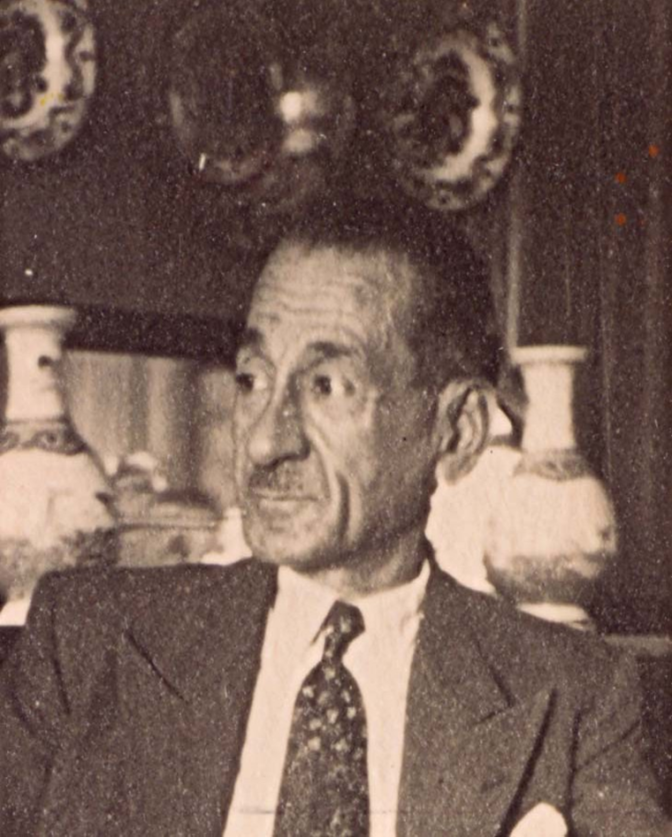Joseph FRANCO
Biographie of Joseph René Franco, his life on the line
Joseph Franco was born in 1888 in Tunis, but lived in Paris for most of his life. A refugee in Lyon during the Occupation, it was there that he was arrested in July 1944. He was then transferred to Drancy camp and from there was deported to Auschwitz on Convoy 77 on July 31, 1944.
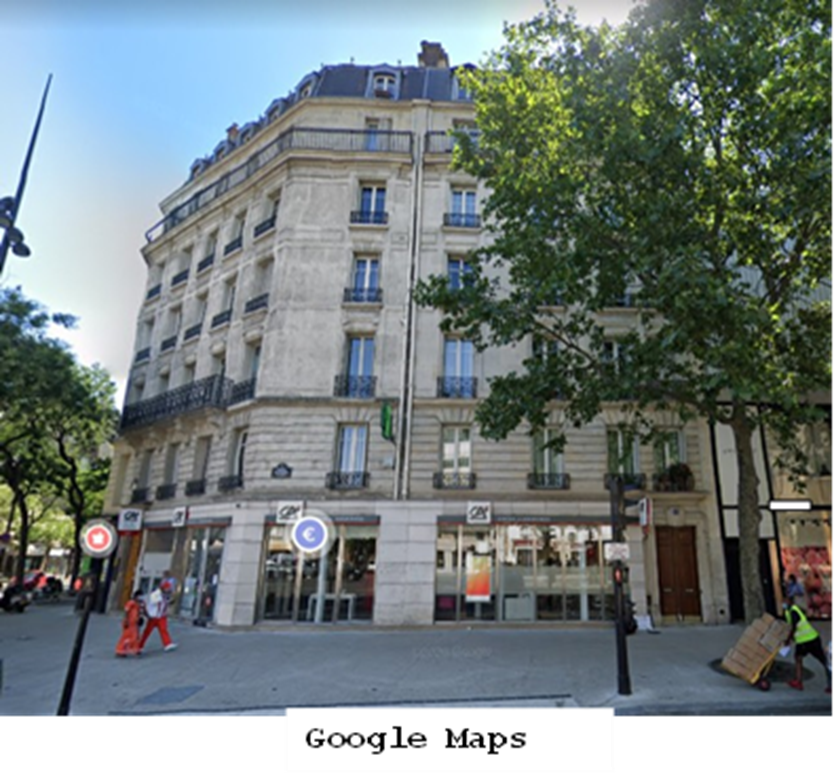
Portrait photo of Joseph Franco
Photograph from the search file
Joseph Franco was born on March 25, 1888 in Tunis, Tunisia. He was murdered on August 5, 1944 in Auschwitz, Poland.
His father’s name was Raphaël Franco, and his mother was Marie Lévy. We were unable to find any further information about them. Joseph was an only child.
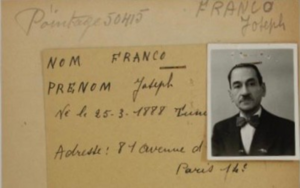
Information about Joseph Franco
SHA 21 P 451 680
In 1922, Joseph left his hometown for France, where he settled in the 14th district of Paris at 81, avenue d’Orléans. He shared a flat with Charles Gilles, a painter, and his wife Jeanne Gilles. He had a very good relationship with them and considered them to be friends. He appears to have had a girlfriend called Jeanne Laroche.

The building at 81, avenue d’Orléans, (now called avenue du Général Leclerc) in 2021
Google Maps

1936 census
Archives.paris.fr
To make a living in the capital, he worked as a salesman. In addition, based on a letter he wrote to his friend Eugene Estèbe, we can assume that he worked for the Finoki shoe store located at 87, Avenue au Maine, in the 14th district of Paris. The fact that he worked as a salesman helps to explain why he is always so smartly dressed in photographs.
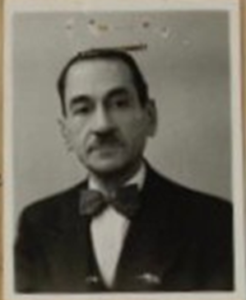
Identity photo of Joseph Franco
SHA 21 P 451 680
The Finoki company had several stores in the city and, according to reports at the time, they were well known in Paris and attracted a lot of customers. The success of this company was mainly due to the fact that they could afford to advertise. The advertisement below was drawn by the illustrator Germaine Bouret, a designer spotted by Walt Disney himself in the 1940s. He even said that she was the greatest illustrator of her time. This shows to what extent the store in which Joseph Franco worked was widely renowned.
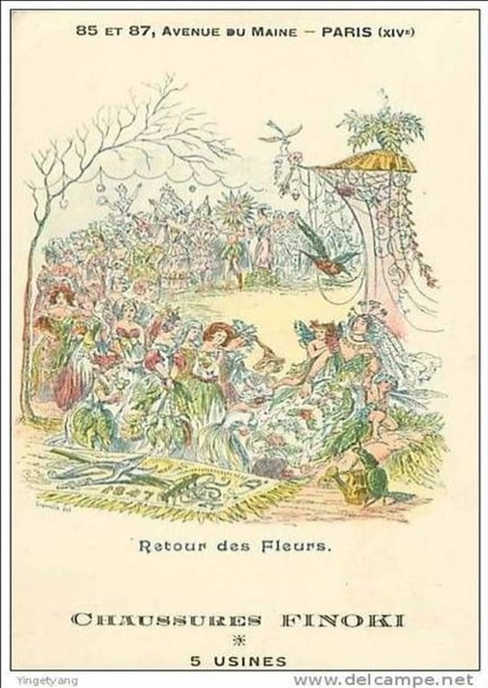
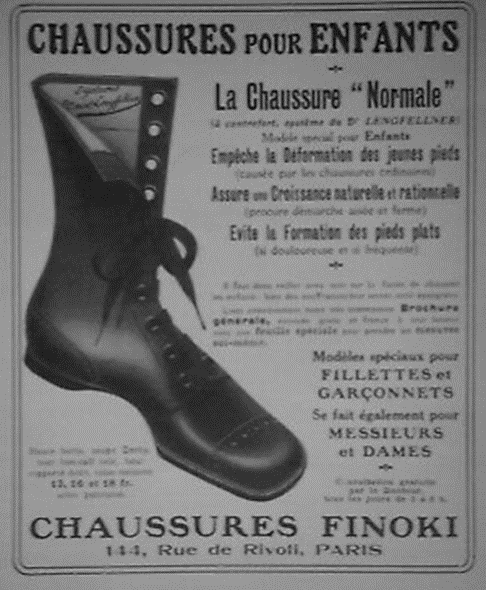
Examples of advertising for Finoki stores
Lastly, the Finoki shoe store was also very important for Joseph Franco in terms of friendship. Indeed, it was here that he met his friend Eugène Estèbe, with whom he remained very close. This is apparent in the letter that Joseph wrote to him from Drancy.
Due to the anti-Semitic policy introduced by the collaborationist regime under Marshal Pétain, on September 3, 1941, Joseph Franco finally left Paris in order to seek refuge in the non-occupied zone. He chose to settle in Lyon. Once there, he found sanctuary at the home of a Madame Berle. She lived at number 6 rue Neuve, a few hundred yards from Place des Terreaux.
Finally, after living in hiding for three years at Madame Berle’s house, he was arrested there on July 10, 1944. Madame Berle later wrote to Joseph’s girlfriend, Jeanne Laroche.
This letter from Madame Berle to Jeanne Laroche is evidence of the kindness Joseph Franco showed to others. Indeed, Madame Berle and her friends were ready to risk their lives to obtain some information that might free him: “some friends are doing their best to find some news and have him released”. Also, it is clear that Jeanne and Joseph were very close, as demonstrated by the fact that she was the first person that Joseph wanted to inform of his arrest. Joseph must also have had a good relationship with Madame Berle, because she was committed to hiding him and was devastated when he was arrested.

Letter from Madame Berle to Jeanne Laroche, telling her that Joseph Franco had been arrested
SHA 21 P 451 680
And so began his journey to hell…
Joseph Franco was first detained in Montluc prison for nearly two weeks. This symbolic detention facility, which bears witness to the repression during the Second World War, opened its doors in 1921; it was a military prison until 1926, then a civilian prison until 1932, when it was closed. It takes its name from Fort Montluc, which lies across the street. In 1939, the prison reopened. First, from 1940 to 1943, it was managed by the Vichy regime authorities. It was then requisitioned by the Nazi occupiers until August 1944. During the German occupation, nearly 10,000 men, women and children were interned there. Among the prisoners were the children from the Izieu children’s home, and Jean Moulin, who was held in cell 130.

Montluc prison during the war
After a brief stay in Montluc, Joseph Franco was transferred by train to Drancy on July 24, 1944, as evidenced by the search sheet completed when he arrived.
Drancy is located about 8 miles (12 km) northeast of Paris. It is a U-shaped group of buildings, made up of apartment blocks together with five tall towers (the last of which was never finished). It was one of the city’s first large-scale developments. The 15-story towers were demolished in the 1970s. Building began in 1932. It was intended to be low-income housing, but the project never got off the ground due to the financial crisis at the time. Besides, the apartment blocks in Drancy were not near any economically active areas. For example, there were no factories nearby, and therefore no potential tenants for the available apartments. The buildings were therefore quickly transformed into barracks for the military police. At the time, Drancy camp was called “la cité de la Muette” and it was considered to be ultra-modern. Its towers were the highest in France.

The locations of the Bobigny and Le Bourget railroad stations in relation to Drancy
www.garedeportation.bobigny.fr

People who had been rounded up arriving at Drancy camp in August 1941
www.ajpn.org
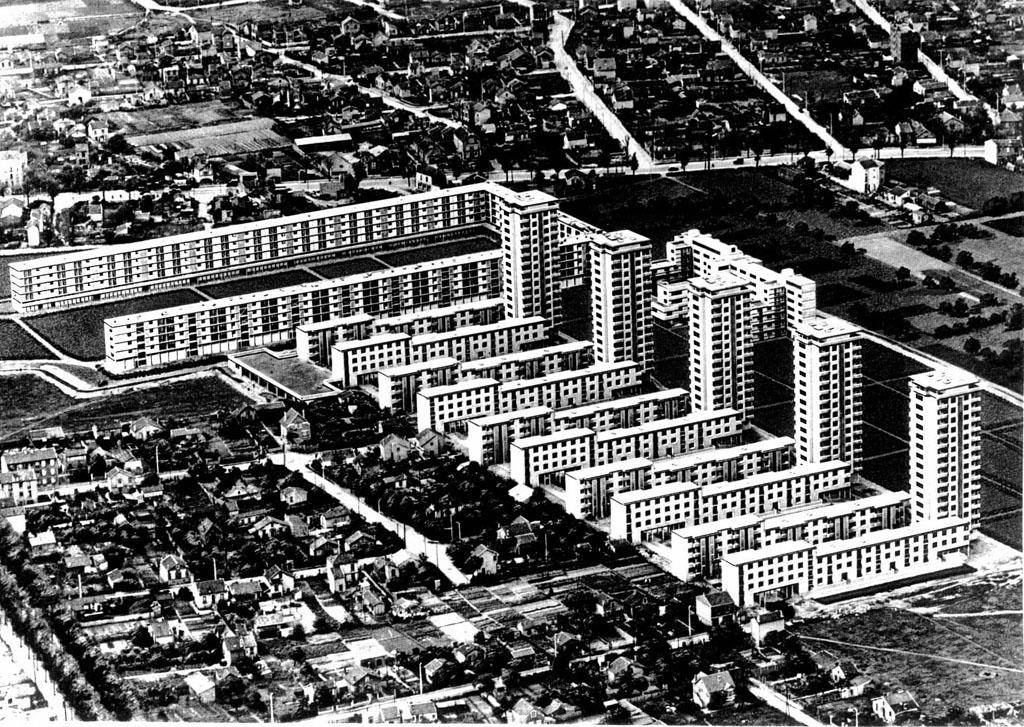
Drancy in the 1930s
www.pinterest.fr

Plan showing the location of Drancy
france3-regions.francetvinfo.fr
From August 20, 1941 onwards, the Cité de la Muette housed the 4,232 Jews rounded up in the eastern districts of Paris. The men interned were between 18 and 50 years old and were Polish, Romanian, Russian and also French.
Until the major round-ups in the summer of 1942, Drancy was a reservoir of hostages. The first convoy of deportees to Auschwitz left Le Bourget railroad station on March 27, 1942. 1,112 men, aged 18 to 60, were deported. Only about 20 of them made it back in 1945. In July 1943, a Nazi commander opted for another, more discreet railroad station, Bobigny. During its three-year existence, the Drancy camp was under the successive management of SS Theodor Dannecker (until July 1942), Heinz Röthke (until June 1943) and Alois Brunner from July 1943. Brunner received his orders directly from Adolf Eichmann.
The Vel d’Hiv roundup of July 16 and 17, 1942 marked the beginning of a second phase in the life of the camp. Women and children were now included among the internees. Between July 19 and November 11, 1942, 31 convoys left the camp, carrying 29,878 people. Others followed in 1943 and 1944, the last one leaving on August 17, 1944 from Bobigny railroad station. In total, 63 transports were organized. They took 65,000 people to the killing centers, mainly to Auschwitz-Birkenau.
The first place every newcomer went to was the search room. It was the first stage of dehumanization, where all objects, identity cards and passports were confiscated. The internees were then registered: last name, first name, address, place where they came from, and why they were in Drancy (failure to wear the yellow star, being on the wrong side of the demarcation line etc.). Finally, they were given their room number.
The living conditions were appalling and highly regimented. The prisoners had almost nothing; some did not even have a bed or a blanket. They were kept in their rooms for most of the day, so doing nothing was their only option. The children, who arrived in August 1942, were separated from their parents. They did not even have a bed to sleep in and were forced to sleep on simple straw mats, or even on the floor. As soon as he arrived, Joseph Franco wrote a letter to Eugène Estèbe. We know from this letter where he stayed in Drancy camp: the 4th floor on staircase 5.
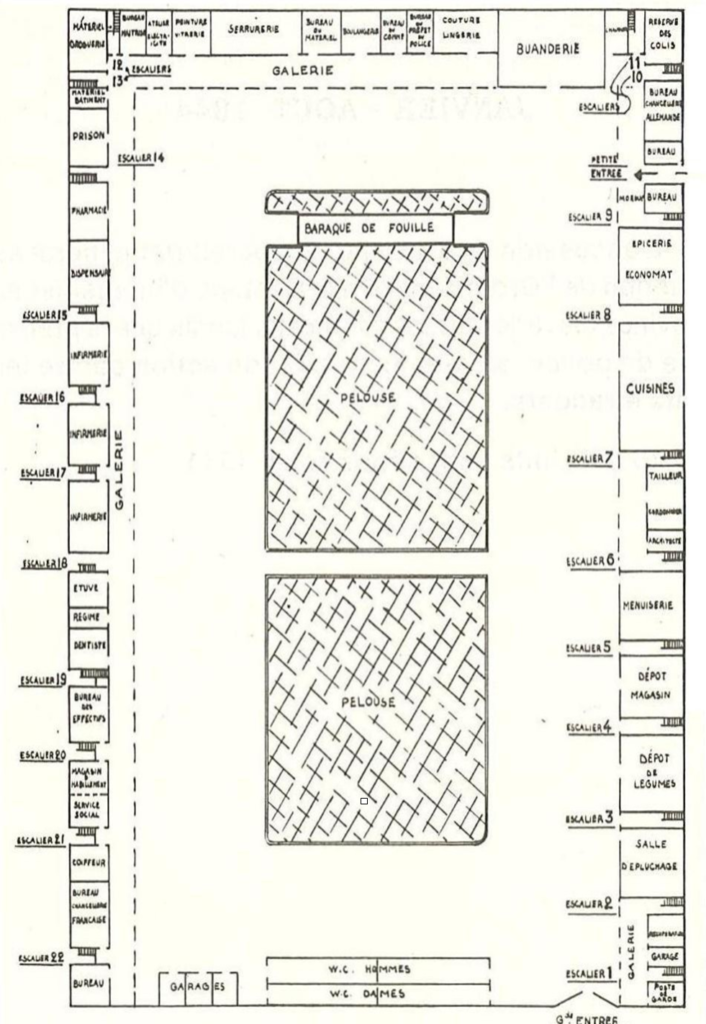
Plan of the ground floor of Drancy camp
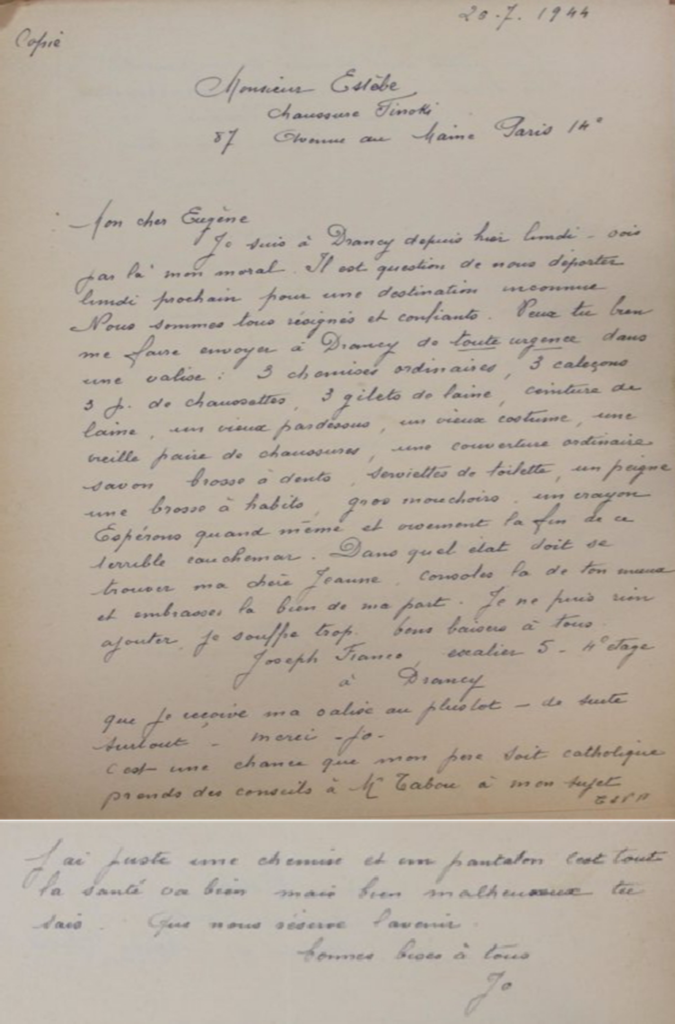
Joseph Franco’s letter to Eugène Estèbe, written in Drancy
SHA 21 P 451 680
Joseph Franco wrote this letter the day after he arrived at Drancy.
In the letter, he tells his friend that he is to be deported “to an unknown destination” the following Monday. He therefore asks him to send him a suitcase containing clothes and toiletries as a matter of urgency. The cynicism of the Nazis, who led the deportees to believe that they were being deported to work in the East, is evident here. In the minds of the deportees, if they were asked to take a suitcase with personal belongings, it meant that they were going to live. He explains that he and his fellow prisoners are resigned to their fate, yet confident.
He talks about his feelings, saying that he is not in good spirits and writes: “Let’s hope anyway and look forward to the end of this terrible nightmare”. He is worried about his girlfriend, Jeanne Laroche, and asks his friend to console her as best he can.
He also touches on a very important subject. He mentions the fact that his father is a Catholic. There are several possibilities here. Either his father was really born Catholic, or he converted to Catholicism later in life, or he gave this information so that the camp authorities would take it into account and postpone his deportation. He would have been aware that letters were read before they were sent and this could have been a desperate attempt to escape deportation. In either case, this would mean that in theory he was not “deportable”, although there are many examples that show that in the frantic climate of arrests and deportations this criterion was not always adhered to.
He ends his letter by saying “my health is fine but I am very unhappy”. This is the last ever letter from a man who was devastated by his plight. He was deported to Auschwitz on July 31, 1944, and was probably murdered on arrival at the camp on account of his age.
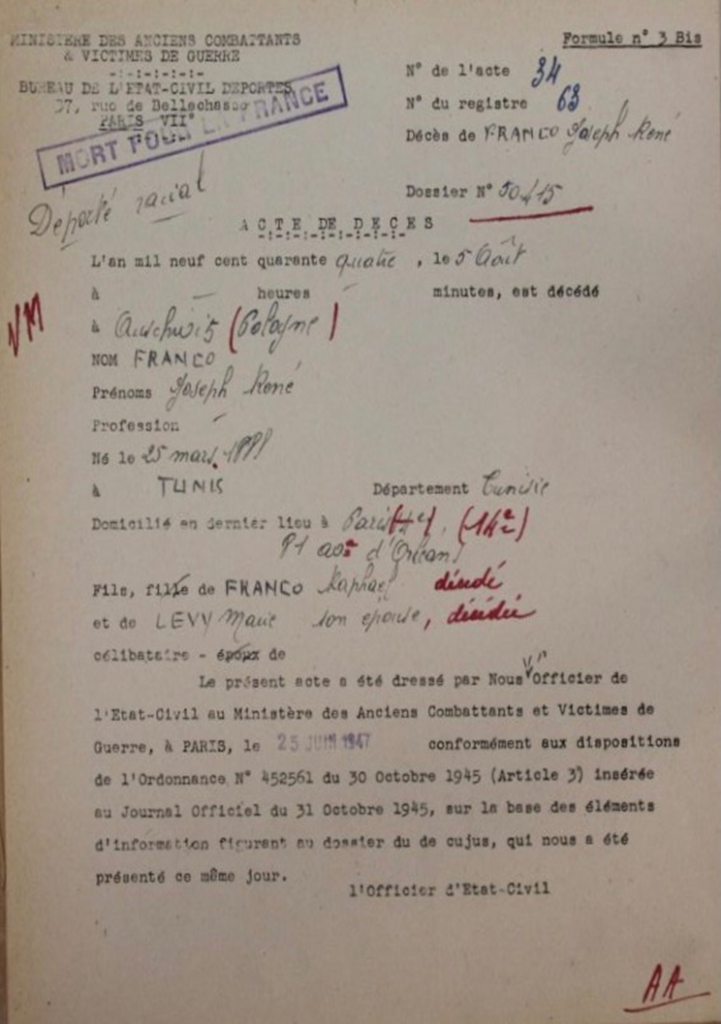
Joseph Franco’s death certificate
SHA 21 P 451 680
As we are doing now, some other people have tried to research what happened to Joseph Franco during the Holocaust. One of them was Jeanne Laroche, who was his girlfriend, another was Mireille Boccara Cacoub, who was his second cousin, and another was Gilles André.
Here are several archived documents related to this research:
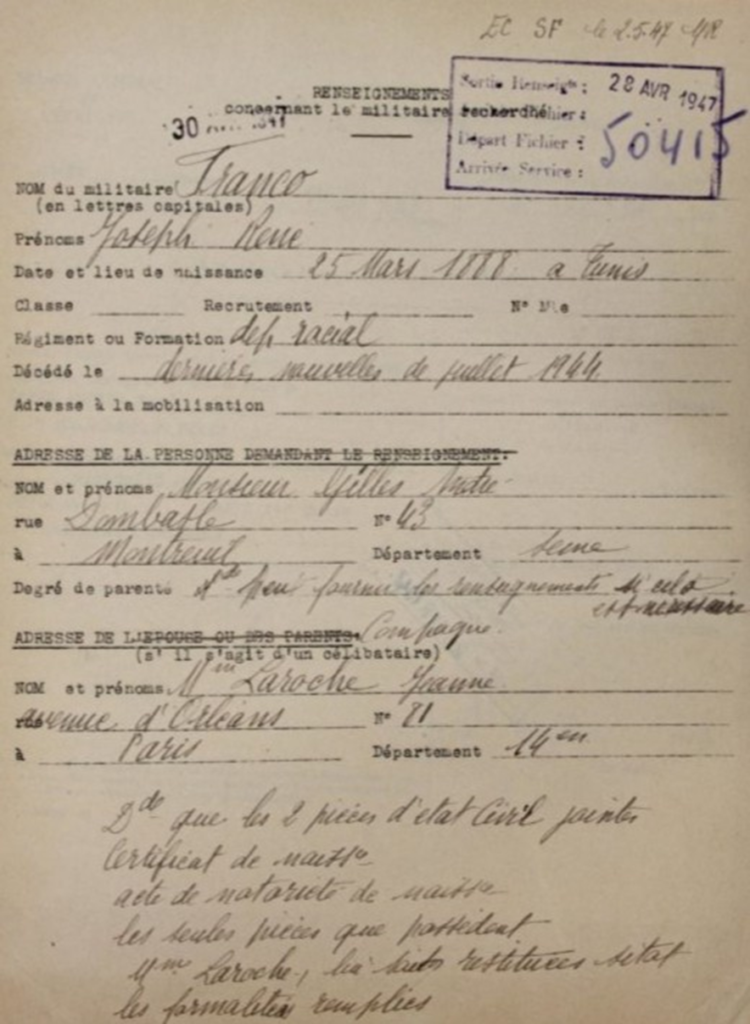
Information sheet, requested by Gilles André
SHA 21 P 451 680
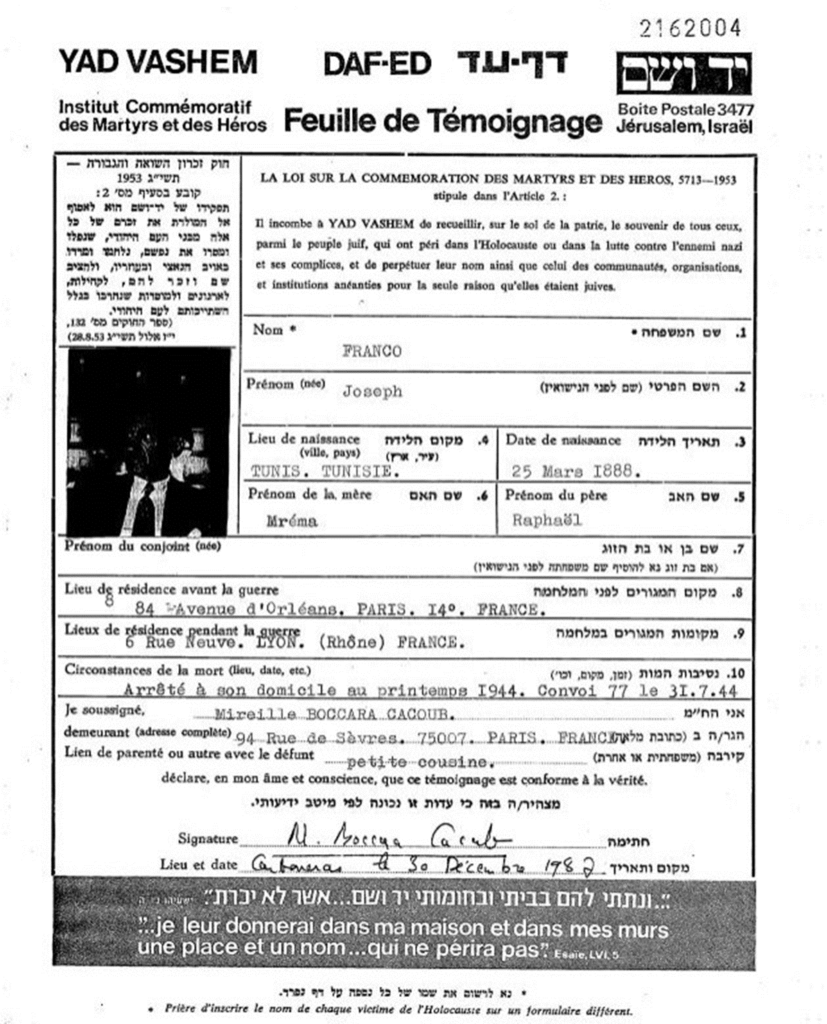
Testimonial sheet submitted by Mireille Boccara- Cacoub
https://www.yadvashem.org/

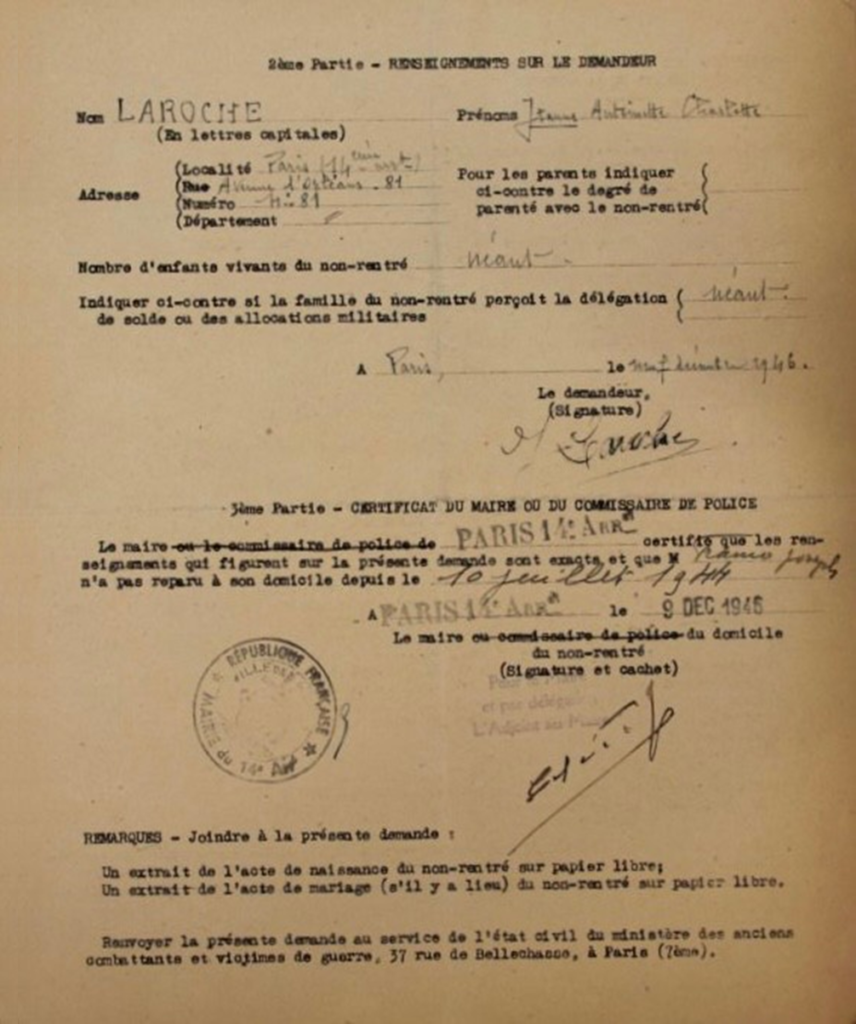
Information sheet requested by Jeanne Laroche
SHA 21 P 451 680
Sources
Defense Historical Service
- Victims of Contemporary Conflicts Archives Division (DAVCC), of the Ministry of Defense Historical Service, in Caen, dossier n° 21 P 451 680
The Shoah Memorial in Paris
- Drancy records, search book and transfer register
Contacts via social networks with a descendant of Mireille Boccara-Cacoub, his second cousin

جوزيف فرانكو
1888- 1944/ الولادة : تونس / الاعتقال : ليون / الإقامة : ليون، باريس
سيرة جوزيف روني فرانكو في مسار الحياة
ولد جوزيف فرانكو سنة 1888 بتونس وعاش في باريس فترة طويلة من حياته. لجأ إلى ليون في فترة الاحتلال، واعتقل هناك في يوليوز 1944 قبل إرساله إلى معتقل درانسي وترحيله إلى أوشفيتز عبر القافلة 77 يوم 31 يوليوز 1944.

بورتريه لجوزيف فرانكو
. صورة مأخوذة من ملف البحث
والد جوزيف يسمى رفائيل فرانكو ووالدته ماري ليفي. ولم نعثر على مزيد من المعطيات حولهما، فجوزيف هو الابن الوحيد للعائلة.

عناصر هوية جوزيف فرانكو
SHA 21 P 451 680
في 1922 غادر جوزيف مسقط رأسه نحو فرنسا حيث استقر في الدائرة 14 في باريس برقم 81 شارع أورليان. كان يعيش في مسكن مكترى مشترك مع شارل جيل، فنان تشكيلي وزوجته جان جيل. كانت علاقته معهما جيدة، بل يعتبرهما أصدقاء له. ويظهر أن جوزيف كانت له رفيقة تسمى جان لا روش.

منظر للعمارة في 2021، رقم 81 شارع أورليان (شارع الجنرال لوكليرك حاليا)

إحصاء سنة 1936
(أرشيفات موقع باريس)
وحتى يتمكن من العيش في العاصمة الفرنسية، مارس مهنة ممثل شركة. فضلا عن ذلك، وبفضل رسالته إلى صديقه أوجين إستيب نستطيع افتراض بأنه كان يعمل لصالح متجر الأحذية فينوكي الكائن برقم 87 شارع الماين في الدائرة 14 بباريس. عمله هذا كممثل شركة هو ما يفسر ظهوره في الصور أنيق اللباس.

صورة هوية جوزيف فرانكو
SHA 21 P 451 680
تمتلك مؤسسة فينوكي عدة متاجر في المدينة. وحسب شهادات من تلك المرحلة، كانت تلك المتاجر جد معروفة في باريس وتجذب الكثير من الزبناء. وإذا كانت هذه المؤسسة قد عرفت كل هذا النجاح فذلك ناتج خاصة لكونها تمكّنت من نشر صفحات إعلانية. ويمكن أن نلاحظ بأن الإعلان المرفق أُنجز من طرف الرسامة جيرمين بوري، التي استقطبها والت ديزني شخصيا، في سنوات الأربعينيات. بل إنّ هذا الأخير اعتبر جيرمين أكبر رسّامة في زمنها. وهذا ما يُظهر إلى أي حد كان المتجر الذي يعمل به جوزيف فرانكو معروفا جدا


نماذج من صفحات إعلانية لمتاجر فينوكي
ويعتبر متجر الأحذية فينوكي أيضا في غاية الأهمية بالنسبة لجوزيف فرانكو على صعيد خلْق صداقات شخصية. إذ هناك التقى صديقه أوجين إستيب الذي كان قريبا منه. هذه الصداقة محسوسة من خلال الخطاب الذي وجهه له من درانسي.
وبسبب السياسة المعادية للسامية التي نهجها النظام المتعاون للمارشال بيتان في ثالث شتنبر 1941، قرّر جوزيف فرانكو مغادرة باريس نحو المنطقة غير المحتلة عسى أن يجد بعض الأمان. اختار الاستقرار بمدينة ليون. وحال وصوله هناك وجد له ملجأ عند السيدة بيرل، التي كانت تسكن في الرقم 6، زنقة نوف، على بعد بضعة مئات الأمتار من ساحة دي تيرو.
وفي الأخير اختفى ثلاث سنوات عند السيدة بيرل، إلى أن تم إلقاء القبض عليه بمسكنه يوم عاشر يوليوز 1944. وفيما بعد كتبت السيدة بيرل إلى رفيقة جوزيف، جان لا روش، رسالة تُظهر فيها حجم اللطف الذي كان يتعامل به جوزيف مع الآخرين. فالسيدة بيرل وأصدقاؤها كانوا فعلا مستعدين للمجازفة بأرواحهم للحصول على بعض المعلومات التي يمكنها أن تساعد على إطلاق سراحه : أصدقاؤه قاموا بما يمكنهم من أجل الحصول على معلومات لإخراجه من الأسْر. إضافة لذلك نفهم بأن جان وجوزيف كانا جد قريبين، يُستشف ذلك من كون هذه الأخيرة كانت أول شخص رغب جوزيف في إبلاغه خبر اعتقاله. كذلك يمكن أن نلاحظ التواطؤ الذي كان بين جوزيف والسيدة بيرل، ما دامت خاطرتْ بحياتها عندما أخْفته، بل إن هذه السيدة أصيبت بصدمة بعد إلقاء القبض عليه.

رسالة من السيدة بيرل إلى جان لا روش تخبرها باعتقال جوزيف فرانكو
SHA 21 P 451 680
هكذا بدأت رحلة جوزيف نحو جهنم…
جوزيف فرانكو سجن أولا في مونتلوك خلال ما يقارب أسبوعين. هذا المكان الرمزي للاعتقال الذي شهد على القمع خلال الحرب العالمية الثانية فتح أبوابه بدءا من 1921، حيث كان سجنا عسكريا حتى 1926، ثم سجنا مدنيا إلى سنة 1932 وهي سنة إغلاقه. أخذ اسمه من حصن مونتلوك التي توجد قبالته. في 1939 أعيد فتح هذا السجن. في البداية من 1940 إلى 1943، تحت إدارة نظام فيشي. وبعد ذلك تم تسخيره من طرف المحتل النازي إلى شهر غشت 1944. وخلال الاحتلال الألماني، سجن به حوالي عشرة آلاف رجل وامرأة وطفل. ومن بين الموقوفين المعروفين، نجد أطفال إيزيو وكذا جان مولان. هذا الأخير كان يقبع في الزنزانة 130.

سجن مونتلوك خلال الحرب
بعد هذه الفترة القصيرة بمونتلوك، نُقل جوزيف فرانكو بالقطار إلى درانسي يوم 24 يوليوز 1944، مثلما تشهد على ذلك بطاقة التفتيش المملوءة يوم وصوله.
معتقل درانسي يوجد على بعد 12 كلم شمال-شرق باريس. وهو مجموعة من البنايات على شكل الحرف الفرنسي U، يتشكل من مجموعة عمارات، مصحوبة بخمس أبراج (الأخير بينها غير مكتمل). هذه المجموعة من البنايات تُمثل واحدة من أوائل المجموعات الكبرى بالمدينة. الأبراج من 15 طبقة تم هدمها في السبعينيات. ذلك أن البنايات شُيدت منذ 1932، وكان من المقرر أن تكون مساكن اجتماعية لكن المشروع لم يكتمل بسبب الأزمة الاقتصادية في تلك المرحلة. إضافة لذلك فهذه العمارات بدرانسي لم تكن مشيّدة في مناطق تعرف بعض الدينامية. إذ لم تكن تحيط بها معامل، مما يعني غياب إمكانية عروض كرائية للشقق المتوفرة. تمّ بسرعة تحويل البنايات إلى ثكنات لفرق الحرس المتحركة للدرك. وفي تلك الفترة كان معتقل درانسي يسمى “حي لا موييت” والذي كان يُعتبر جد حديث وكانت أبراجه الأكثر علوا في فرنسا.

موقع محطتي بوبيني وبورجيه بالنسبة لدرانسي
www.garedeportation.bobigny.fr

وصول المعتقلين إلى المعسكر في غشت 1941
www.ajpn.org

درانسي في الثلاثينيات
www.pinterest.fr

موقع درانسي
france3-regions.francetvinfo.fr
ابتداء من 20 غشت 1941، استقبل حي لا موييت 4.232 يهودي اعتقلوا في أحياء الشرق الباريسي. كان الرجال المعتقلون يبلغون من العمر ما بين 18 و50 سنة، من بينهم بولونيون، ورومانيون، وروس وكذلك فرنسيون.
وحتى تاريخ حملات الاعتقال الكبرى التي حدثت في صيف 1942، كانت درانسي حوضا للرهائن. فالفوج الأول للمرحّلين جرى نقله يوم 27 مارس 1942 انطلاقا من محطة البورجي. بلغ عدد الرجال المرحّلين 1.112 رجلا يتراوح سنهم بين 18 و60 سنة.
حوالي 20 شخصا من بينهم رجعوا سنة 1945. وفي يوليوز 1943، اختار الكومندان النازي محطّة أخرى، متواضعة وغير بارزة، هي محطة بوبيني. وخلال ثلاث سنوات من وجوده كان معتقل درانسي تحت الإدارات المتوالية للقائد النازي تيودور دانكير (حتى يوليوز 1942)، ثم هاينز روتك (حتى يوليوز 1943) وألوا برونير ابتداء من يوليوز 1943. هذا الأخير كان يتلقى الأوامر مباشرة من أدولف أيتشمان.
ودشنت غارة الشرطة في فالديف يومي 16 و17 يوليوز 1942 المرحلة الثانية من حياة المعسكر. حيث جرى أيضا حبس الأطفال والنساء. وبين 19 يوليوز و11 نونبر 1942 غادرت 31 قافلة المعسكر حاملة 29.878 شخصا. قوافل أخرى ستتبعها سنتي 1943 و1944. وغادرت آخر قافلة يوم 17 غشت 1944 محطة بوبيني. تكونت في المجموع 63 قافلة حملت 65.000 شخصا نحو مراكز الموت وخاصة نحو أوشفيتز-بيركوناو.
أول مكان تتم زيارته من قبل كل وافد جديد هو الكوخ الخشبي المخصص لإجراء التفتيش الجسدي. فهو المرحلة الأولى لمحو الإنسانية، هناك تُحجز جميع الأشياء الشخصية وبطاقات التعريف وجوازات السفر. بعد ذلك يتم تسجيل المعتقلين : تقيّد الأسماء العائلية والشخصية، والعنوان، ومكان القدوم والسبب الذي من أجله أرسل الوافدون إلى درانسي (عدم حمل الشارة الصفراء، تجاوز الخط الفاصل). وفي الأخير يُعطى لهم رقم العنبر.
كانت ظروف الحياة هناك كارثية وجد مقنّنة. المعتقلون يحتاجون لكل شيء، بعضهم لا يتوفر على سرير أو غطاء. محروسون داخل عنابرهم طيلة اليوم تقريبا، لا يقومون بشيء. الأطفال الذين وصلوا ابتداء من غشت 1942 يُفصلون عن آبائهم. لا يملكون أسرة ينامون عليها، ويجدون أنفسهم مجبرين على النوم فوق سرير قش أو على الأرض مباشرة. وحال وصوله إلى المعتقل كتب جوزيف فرانكو رسالة وجّهها لأوجين إستيب. بفضل هذه الرسالة نعرف موقعه بمعسكر درانسي وهو الطابق الرابع، الدرج الخامس

تصميم الطابق السفلي في معسكر درانسي

رسالة جوزيف فرانكو إلى أوجين إستيب كتبت في درانسي
SHA 21 P 451 680
جوزيف فرانكو كتب هذه الرسالة غداة وصوله إلى درانسي. وفيها يقول لصديقه بأنه سيُرسل الاثنين المقبل “نحو وجهة غير معروفة”. ويطلب منه أن يبعث له سريعا بحقيبة مع بعض الملابس وأدوات النظافة. هنا نلاحظ في الثنايا السخرية التي يتعامل بها النازيون حين يجعلون المعتقلين يظنون بأنهم سيرحّلون للعمل في الشرق. ففي ذهن المعتقلين أنه إذا طلب منهم حمل حقيبة تتضمن حاجيات شخصية فذلك معناه أنهم سيظلون على قيد الحياة. وهو ما يُفسر إلى أي حد كان هو ورفاقه في سوء الحظ مستسلمين ومطمئنين.
ثم يتحدث عن عواطفه فيقول بأنه لا يملك المعنويات، ويكتب “نتمنى مع ذلك وبحرارة نهاية هذا الكابوس الكريه” ويعبر عن قلقه على رفيقته جان لا روش ويطلب من صديقه مواساتها بأكثر ما يستطيع.
ويتطرق في الرسالة إلى معطى رئيسي حينما يشير إلى أن والده كاثوليكي. وهنا يمكن إثارة عدة فرضيات، فإما أن والده هو فعلا كاثوليكي منذ ولادته أو أنه تحوّل إلى هذا الدين، وإما أنه يقدم هذه المعلومة على أساس أن تأخذها سلطات المعسكر بعين الاعتبار وتتريث بشأن ترحيله. ذلك أنه يعرف بأن المراسلات تُراقب. وقد تكون هذه محاولة ميؤوسة لتفادي الترحيل. وفي الحالتين قد يمكنه ذلك نظريا بأن يكون “غير قابل للترحيل”. بغض النظر عن وجود أمثلة كثيرة تُفيد أنه في مثل هذا السياق الهستيري من الاعتقالات و التّرحيل فإن هذا المعيار لا يُحترم.
وينهي رسالته بالقول “إن حالته الصحية لا بأس بها ولكنه “حزين”. تلك آخر رسالة لشخص محطّم بمصيره. وقد رُحل إلى أوشفيتز يوم 31 يوليوز 1944، وبدون شك تمت تصفيته حال وصوله إلى المعسكر بالنظر لسنه.

شهادة وفاة جوزيف فرانكو
SHA 21 P 451 680
واليوم حاول بعض الناس مثلنا مباشرة أبحاث حول مصيره إبان المحرقة. وهي حالة جان لا روش التي كانت رفيقته، وميراي بوكارا-كاكوب والتي كانت ابنة خالته وجيل أندريه.
وهذه عدة وثائق أرشيفية عن هذه الأبحاث :

بطاقة معلومات طلبها جيل أندريه
SHA 21 P 451 680

شهادة ميراي بوكارا-كاكوب
https://www.yadvashem.org/


بطاقة معلومات طلبتها جان لا روش
SHA 21 P 451 680
إنجاز :
تلاميذ الفصل الثاني بالثانوية الدولية شارل دو كول بمدينة ديجون، تحت إدارة ديميتري فوزيل أستاذ التاريخ والجغرافيا (السنوات الدراسية 2020-2022)


 Français
Français Polski
Polski